Economics Assignment: Market Structures, Competition, and Oligopoly
VerifiedAdded on 2021/06/18
|16
|2197
|248
Homework Assignment
AI Summary
This economics assignment delves into various market structures, analyzing the characteristics and behaviors of firms within each. The assignment begins with an examination of perfect competition, exploring the shareholder market of BP as an example and analyzing market equilibrium, marginal cost, and profit maximization. It then transitions to a discussion of monopoly, evaluating profit maximization, and the ability of a monopolist to maintain supernormal profits. The assignment further investigates monopolistically competitive markets, using the Auckland city café market as an example, and examines the impact of new firms entering the market. Finally, it explores oligopoly markets, defining characteristics like interdependence, entry barriers, and group behavior, and analyzes the success factors of cartels, such as OPEC and CIPEC. The assignment covers key concepts such as marginal revenue, marginal cost, and the impact of market entry and exit on firm profitability, providing a comprehensive overview of market dynamics and firm strategies.
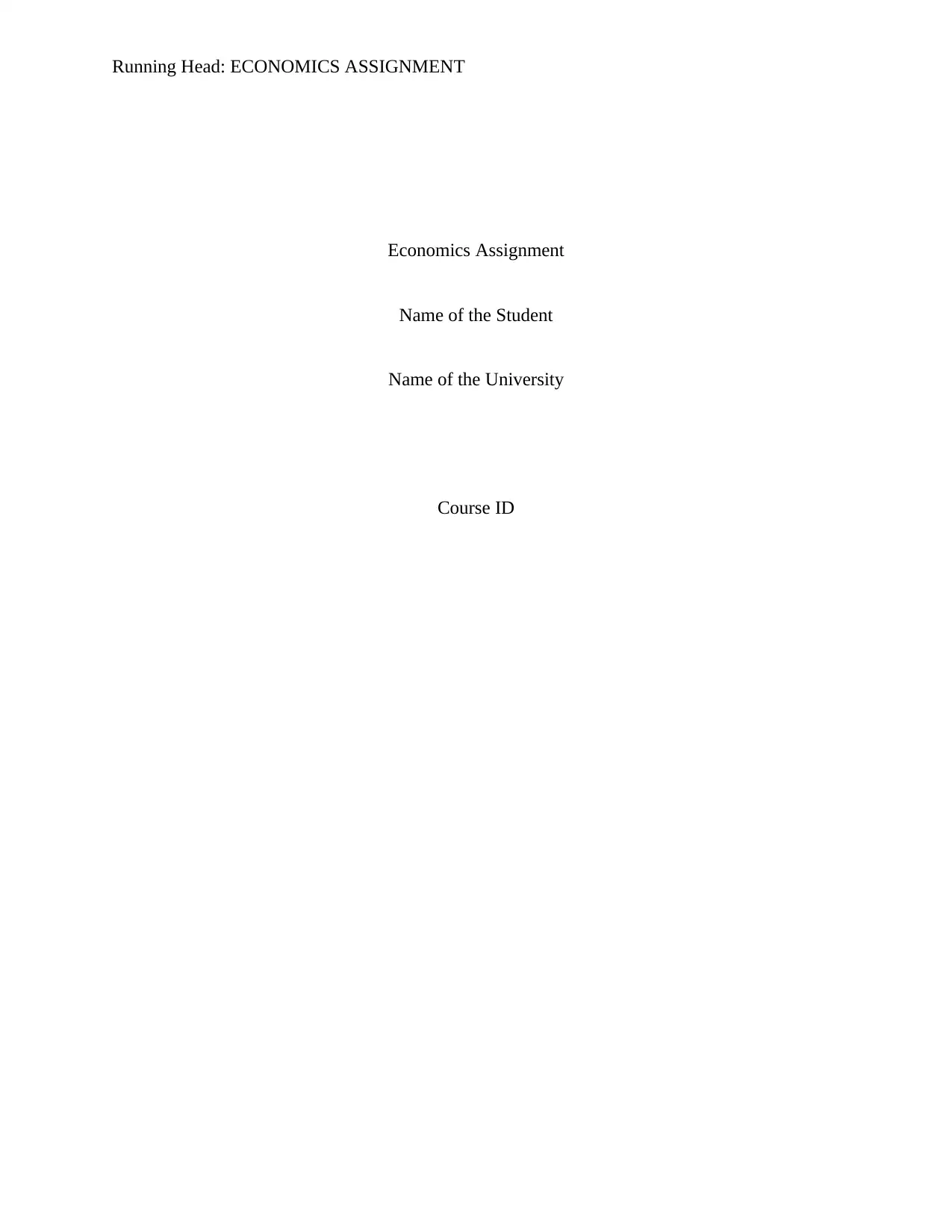
Running Head: ECONOMICS ASSIGNMENT
Economics Assignment
Name of the Student
Name of the University
Course ID
Economics Assignment
Name of the Student
Name of the University
Course ID
Paraphrase This Document
Need a fresh take? Get an instant paraphrase of this document with our AI Paraphraser
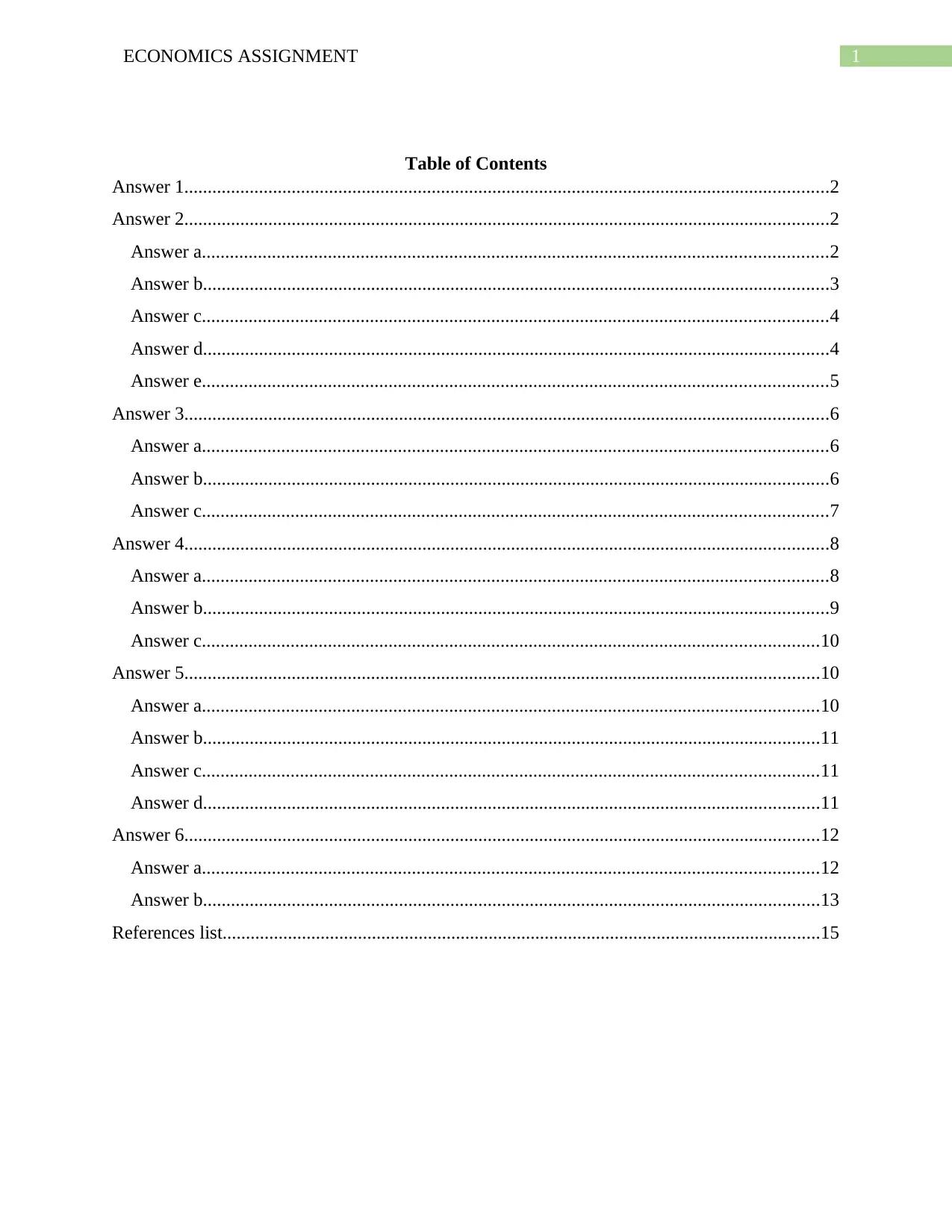
1ECONOMICS ASSIGNMENT
Table of Contents
Answer 1..........................................................................................................................................2
Answer 2..........................................................................................................................................2
Answer a......................................................................................................................................2
Answer b......................................................................................................................................3
Answer c......................................................................................................................................4
Answer d......................................................................................................................................4
Answer e......................................................................................................................................5
Answer 3..........................................................................................................................................6
Answer a......................................................................................................................................6
Answer b......................................................................................................................................6
Answer c......................................................................................................................................7
Answer 4..........................................................................................................................................8
Answer a......................................................................................................................................8
Answer b......................................................................................................................................9
Answer c....................................................................................................................................10
Answer 5........................................................................................................................................10
Answer a....................................................................................................................................10
Answer b....................................................................................................................................11
Answer c....................................................................................................................................11
Answer d....................................................................................................................................11
Answer 6........................................................................................................................................12
Answer a....................................................................................................................................12
Answer b....................................................................................................................................13
References list................................................................................................................................15
Table of Contents
Answer 1..........................................................................................................................................2
Answer 2..........................................................................................................................................2
Answer a......................................................................................................................................2
Answer b......................................................................................................................................3
Answer c......................................................................................................................................4
Answer d......................................................................................................................................4
Answer e......................................................................................................................................5
Answer 3..........................................................................................................................................6
Answer a......................................................................................................................................6
Answer b......................................................................................................................................6
Answer c......................................................................................................................................7
Answer 4..........................................................................................................................................8
Answer a......................................................................................................................................8
Answer b......................................................................................................................................9
Answer c....................................................................................................................................10
Answer 5........................................................................................................................................10
Answer a....................................................................................................................................10
Answer b....................................................................................................................................11
Answer c....................................................................................................................................11
Answer d....................................................................................................................................11
Answer 6........................................................................................................................................12
Answer a....................................................................................................................................12
Answer b....................................................................................................................................13
References list................................................................................................................................15
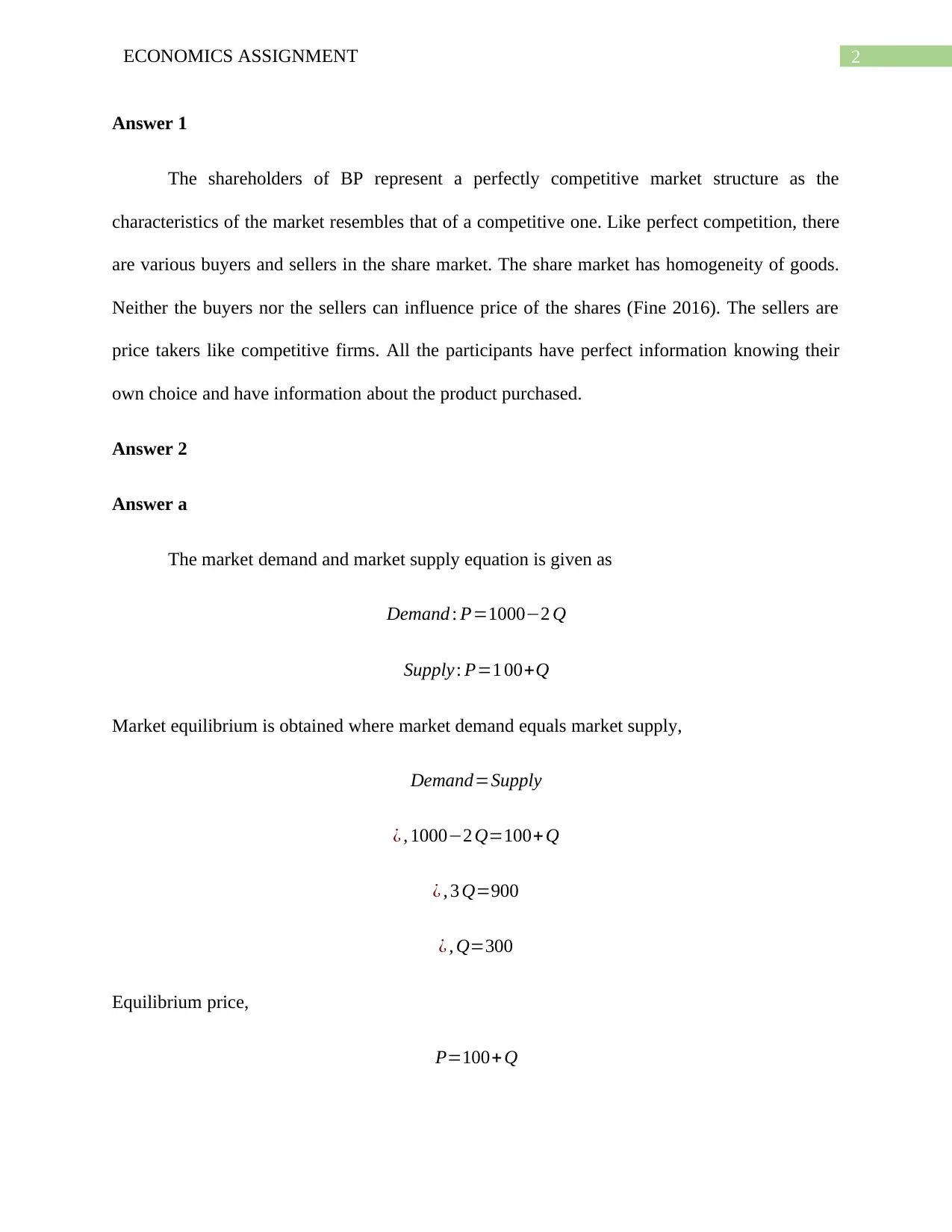
2ECONOMICS ASSIGNMENT
Answer 1
The shareholders of BP represent a perfectly competitive market structure as the
characteristics of the market resembles that of a competitive one. Like perfect competition, there
are various buyers and sellers in the share market. The share market has homogeneity of goods.
Neither the buyers nor the sellers can influence price of the shares (Fine 2016). The sellers are
price takers like competitive firms. All the participants have perfect information knowing their
own choice and have information about the product purchased.
Answer 2
Answer a
The market demand and market supply equation is given as
Demand : P=1000−2 Q
Supply : P=1 00+Q
Market equilibrium is obtained where market demand equals market supply,
Demand=Supply
¿ , 1000−2 Q=100+Q
¿ , 3 Q=900
¿ , Q=300
Equilibrium price,
P=100+ Q
Answer 1
The shareholders of BP represent a perfectly competitive market structure as the
characteristics of the market resembles that of a competitive one. Like perfect competition, there
are various buyers and sellers in the share market. The share market has homogeneity of goods.
Neither the buyers nor the sellers can influence price of the shares (Fine 2016). The sellers are
price takers like competitive firms. All the participants have perfect information knowing their
own choice and have information about the product purchased.
Answer 2
Answer a
The market demand and market supply equation is given as
Demand : P=1000−2 Q
Supply : P=1 00+Q
Market equilibrium is obtained where market demand equals market supply,
Demand=Supply
¿ , 1000−2 Q=100+Q
¿ , 3 Q=900
¿ , Q=300
Equilibrium price,
P=100+ Q
⊘ This is a preview!⊘
Do you want full access?
Subscribe today to unlock all pages.

Trusted by 1+ million students worldwide
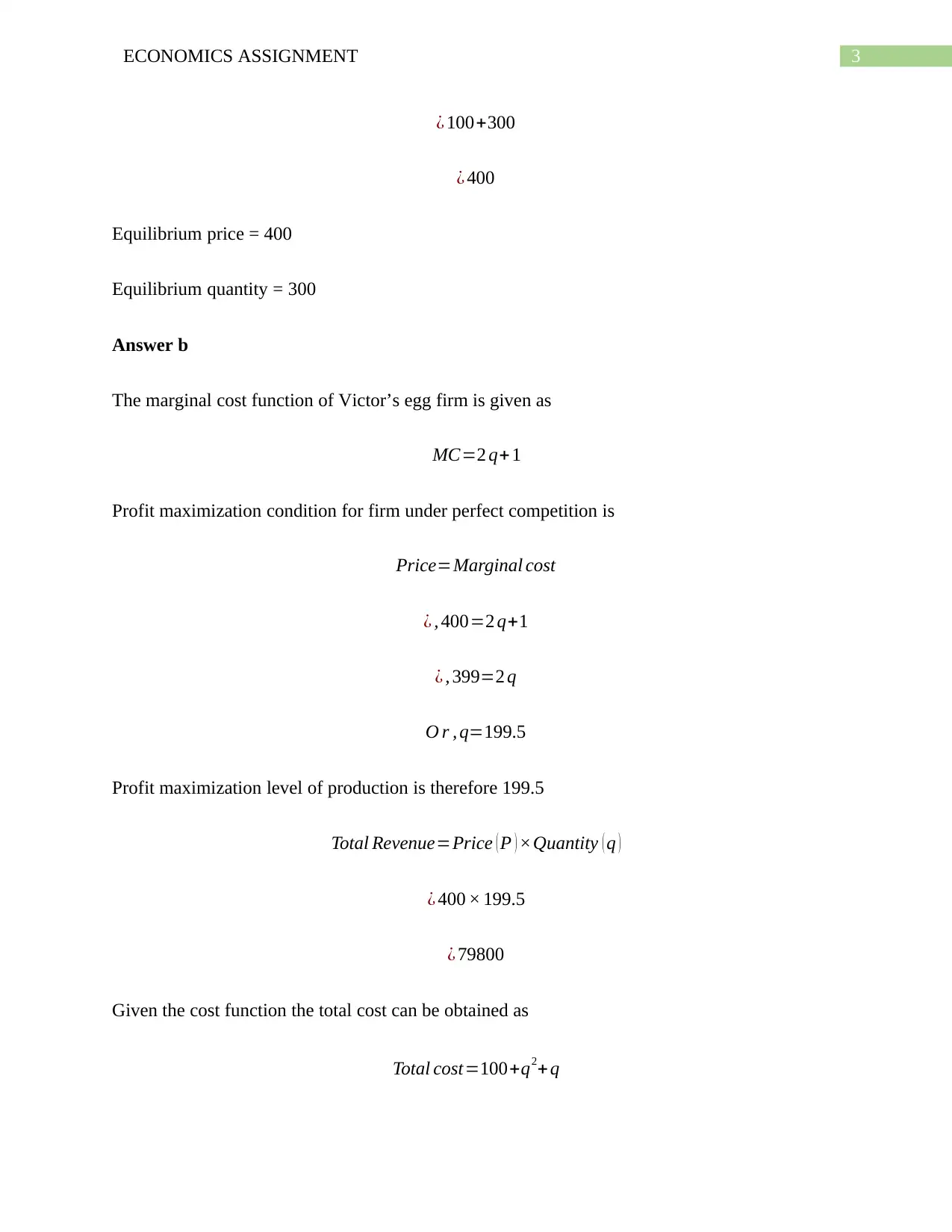
3ECONOMICS ASSIGNMENT
¿ 100+300
¿ 400
Equilibrium price = 400
Equilibrium quantity = 300
Answer b
The marginal cost function of Victor’s egg firm is given as
MC=2 q+ 1
Profit maximization condition for firm under perfect competition is
Price=Marginal cost
¿ , 400=2 q+1
¿ , 399=2 q
O r , q=199.5
Profit maximization level of production is therefore 199.5
Total Revenue=Price ( P ) ×Quantity ( q )
¿ 400 × 199.5
¿ 79800
Given the cost function the total cost can be obtained as
Total cost=100+q2+ q
¿ 100+300
¿ 400
Equilibrium price = 400
Equilibrium quantity = 300
Answer b
The marginal cost function of Victor’s egg firm is given as
MC=2 q+ 1
Profit maximization condition for firm under perfect competition is
Price=Marginal cost
¿ , 400=2 q+1
¿ , 399=2 q
O r , q=199.5
Profit maximization level of production is therefore 199.5
Total Revenue=Price ( P ) ×Quantity ( q )
¿ 400 × 199.5
¿ 79800
Given the cost function the total cost can be obtained as
Total cost=100+q2+ q
Paraphrase This Document
Need a fresh take? Get an instant paraphrase of this document with our AI Paraphraser
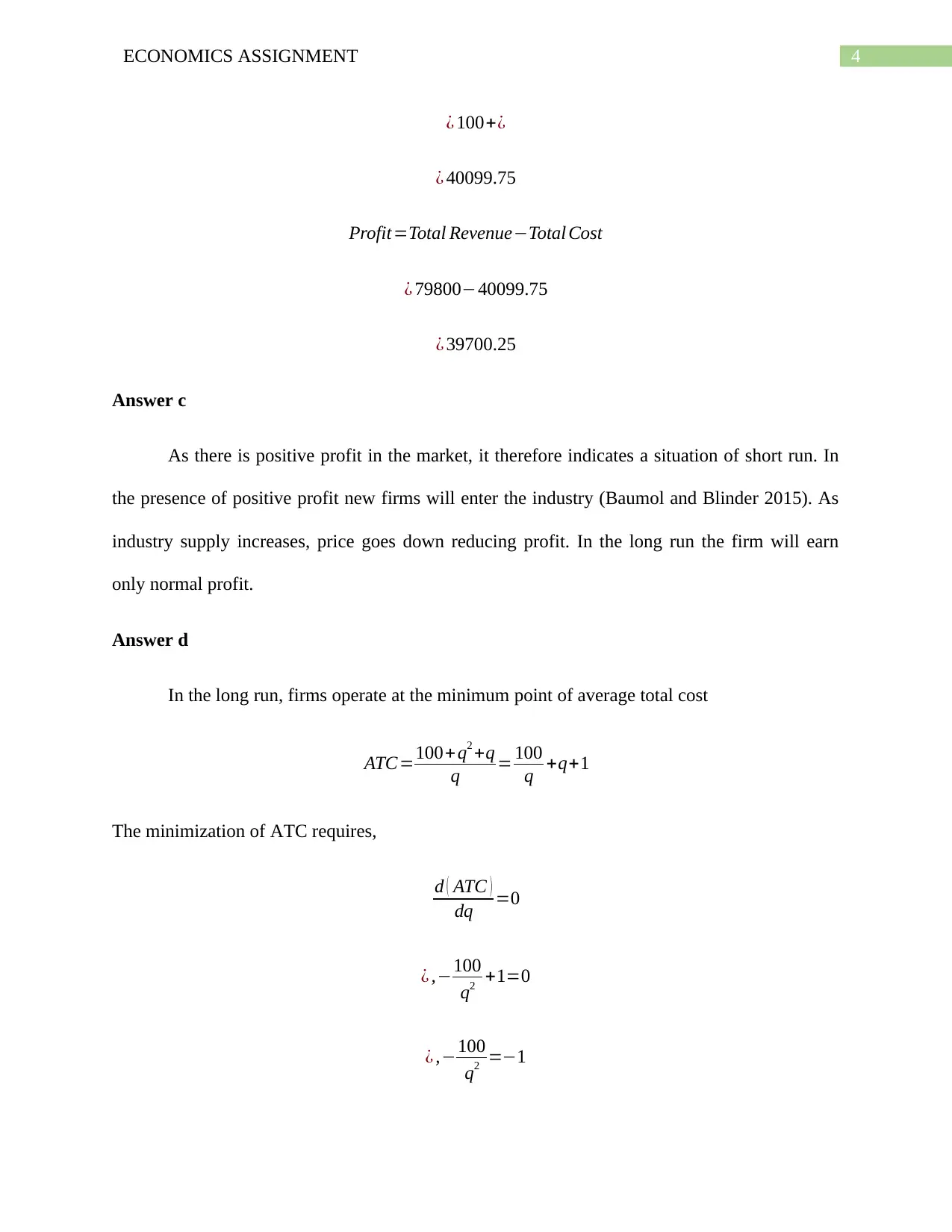
4ECONOMICS ASSIGNMENT
¿ 100+¿
¿ 40099.75
Profit=Total Revenue−Total Cost
¿ 79800−40099.75
¿ 39700.25
Answer c
As there is positive profit in the market, it therefore indicates a situation of short run. In
the presence of positive profit new firms will enter the industry (Baumol and Blinder 2015). As
industry supply increases, price goes down reducing profit. In the long run the firm will earn
only normal profit.
Answer d
In the long run, firms operate at the minimum point of average total cost
ATC=100+ q2 +q
q = 100
q +q+1
The minimization of ATC requires,
d ( ATC )
dq =0
¿ ,−100
q2 +1=0
¿ ,−100
q2 =−1
¿ 100+¿
¿ 40099.75
Profit=Total Revenue−Total Cost
¿ 79800−40099.75
¿ 39700.25
Answer c
As there is positive profit in the market, it therefore indicates a situation of short run. In
the presence of positive profit new firms will enter the industry (Baumol and Blinder 2015). As
industry supply increases, price goes down reducing profit. In the long run the firm will earn
only normal profit.
Answer d
In the long run, firms operate at the minimum point of average total cost
ATC=100+ q2 +q
q = 100
q +q+1
The minimization of ATC requires,
d ( ATC )
dq =0
¿ ,−100
q2 +1=0
¿ ,−100
q2 =−1
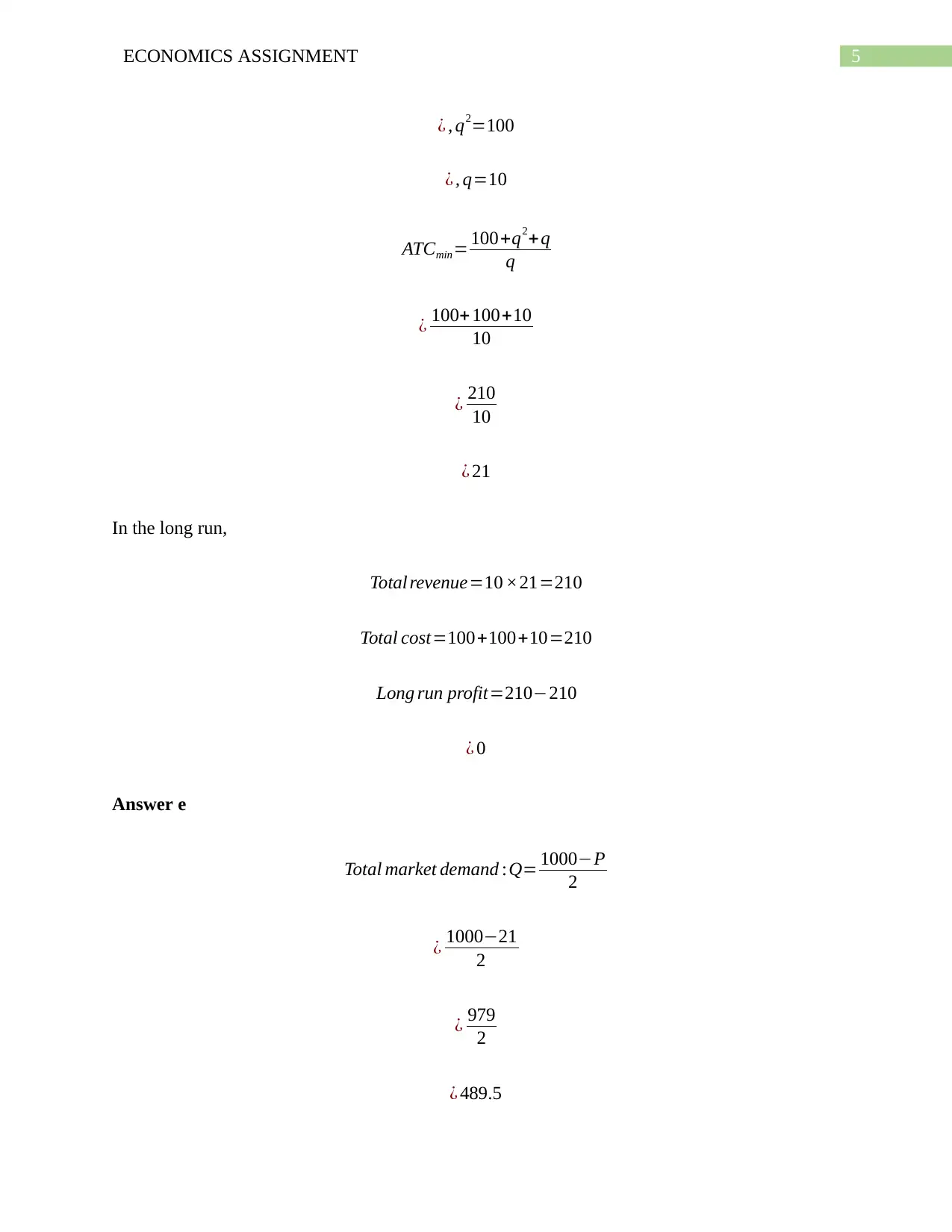
5ECONOMICS ASSIGNMENT
¿ , q2=100
¿ , q=10
ATCmin= 100+q2+q
q
¿ 100+ 100+10
10
¿ 210
10
¿ 21
In the long run,
Total revenue=10 ×21=210
Total cost=100+100+10=210
Long run profit=210−210
¿ 0
Answer e
Total market demand :Q= 1000−P
2
¿ 1000−21
2
¿ 979
2
¿ 489.5
¿ , q2=100
¿ , q=10
ATCmin= 100+q2+q
q
¿ 100+ 100+10
10
¿ 210
10
¿ 21
In the long run,
Total revenue=10 ×21=210
Total cost=100+100+10=210
Long run profit=210−210
¿ 0
Answer e
Total market demand :Q= 1000−P
2
¿ 1000−21
2
¿ 979
2
¿ 489.5
⊘ This is a preview!⊘
Do you want full access?
Subscribe today to unlock all pages.

Trusted by 1+ million students worldwide
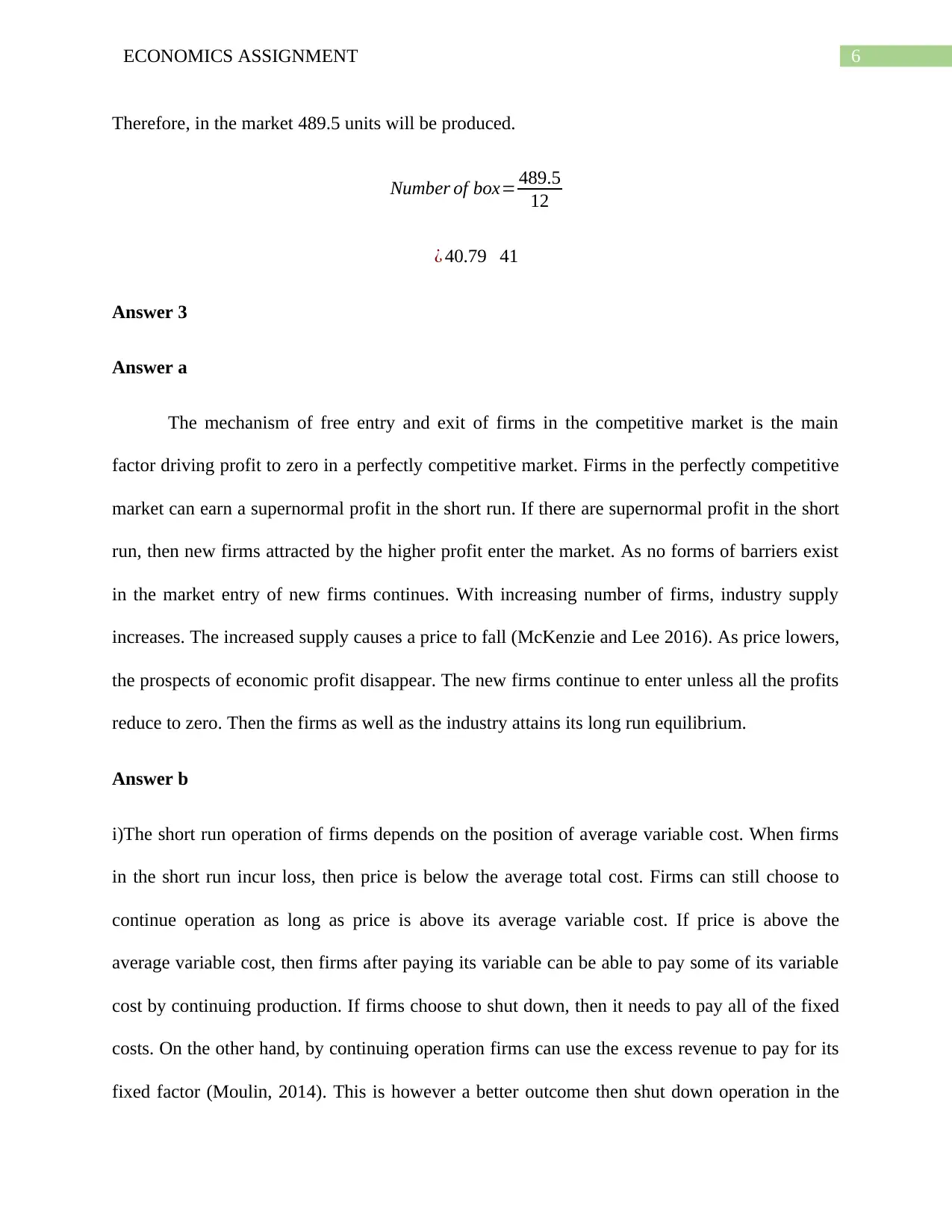
6ECONOMICS ASSIGNMENT
Therefore, in the market 489.5 units will be produced.
Number of box= 489.5
12
¿ 40.79 41
Answer 3
Answer a
The mechanism of free entry and exit of firms in the competitive market is the main
factor driving profit to zero in a perfectly competitive market. Firms in the perfectly competitive
market can earn a supernormal profit in the short run. If there are supernormal profit in the short
run, then new firms attracted by the higher profit enter the market. As no forms of barriers exist
in the market entry of new firms continues. With increasing number of firms, industry supply
increases. The increased supply causes a price to fall (McKenzie and Lee 2016). As price lowers,
the prospects of economic profit disappear. The new firms continue to enter unless all the profits
reduce to zero. Then the firms as well as the industry attains its long run equilibrium.
Answer b
i)The short run operation of firms depends on the position of average variable cost. When firms
in the short run incur loss, then price is below the average total cost. Firms can still choose to
continue operation as long as price is above its average variable cost. If price is above the
average variable cost, then firms after paying its variable can be able to pay some of its variable
cost by continuing production. If firms choose to shut down, then it needs to pay all of the fixed
costs. On the other hand, by continuing operation firms can use the excess revenue to pay for its
fixed factor (Moulin, 2014). This is however a better outcome then shut down operation in the
Therefore, in the market 489.5 units will be produced.
Number of box= 489.5
12
¿ 40.79 41
Answer 3
Answer a
The mechanism of free entry and exit of firms in the competitive market is the main
factor driving profit to zero in a perfectly competitive market. Firms in the perfectly competitive
market can earn a supernormal profit in the short run. If there are supernormal profit in the short
run, then new firms attracted by the higher profit enter the market. As no forms of barriers exist
in the market entry of new firms continues. With increasing number of firms, industry supply
increases. The increased supply causes a price to fall (McKenzie and Lee 2016). As price lowers,
the prospects of economic profit disappear. The new firms continue to enter unless all the profits
reduce to zero. Then the firms as well as the industry attains its long run equilibrium.
Answer b
i)The short run operation of firms depends on the position of average variable cost. When firms
in the short run incur loss, then price is below the average total cost. Firms can still choose to
continue operation as long as price is above its average variable cost. If price is above the
average variable cost, then firms after paying its variable can be able to pay some of its variable
cost by continuing production. If firms choose to shut down, then it needs to pay all of the fixed
costs. On the other hand, by continuing operation firms can use the excess revenue to pay for its
fixed factor (Moulin, 2014). This is however a better outcome then shut down operation in the
Paraphrase This Document
Need a fresh take? Get an instant paraphrase of this document with our AI Paraphraser
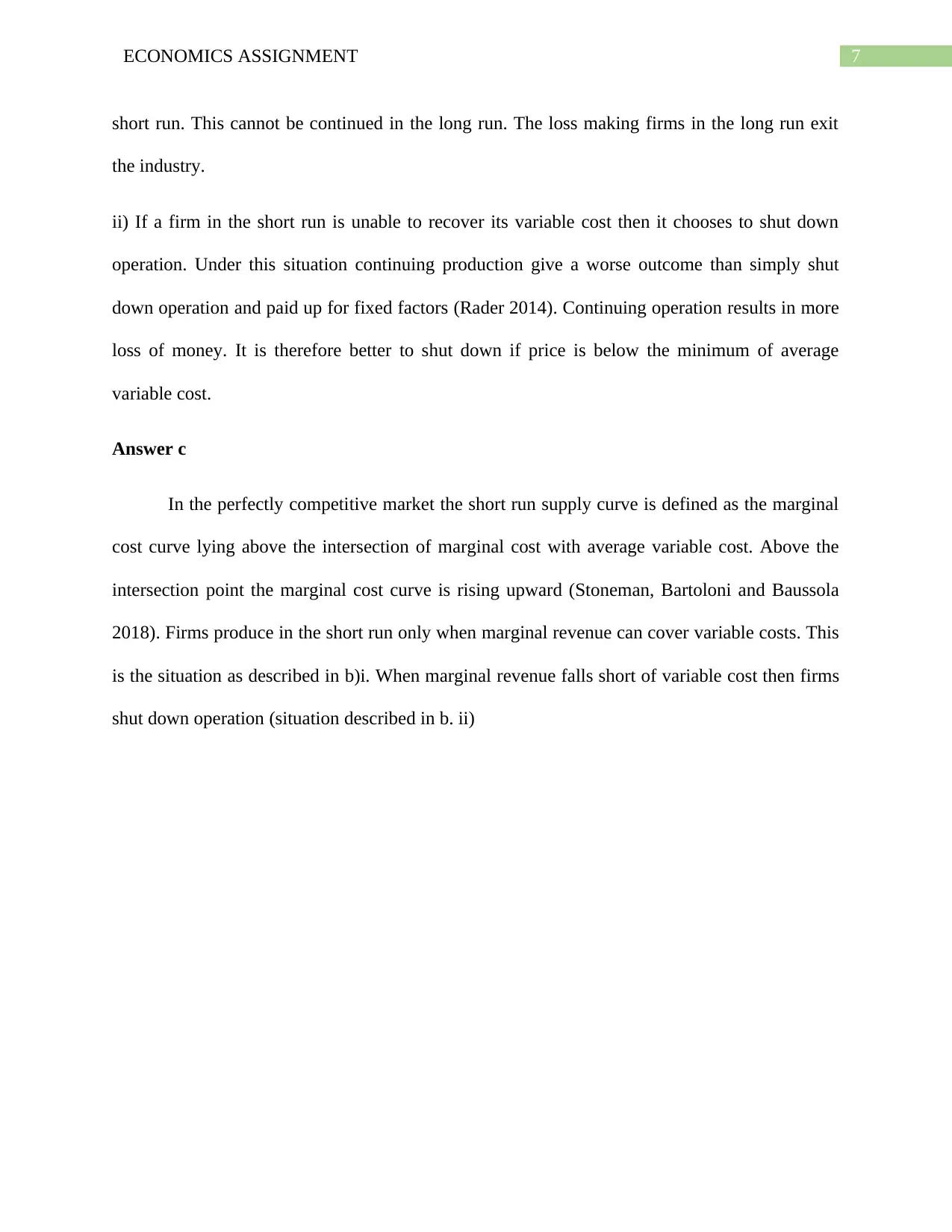
7ECONOMICS ASSIGNMENT
short run. This cannot be continued in the long run. The loss making firms in the long run exit
the industry.
ii) If a firm in the short run is unable to recover its variable cost then it chooses to shut down
operation. Under this situation continuing production give a worse outcome than simply shut
down operation and paid up for fixed factors (Rader 2014). Continuing operation results in more
loss of money. It is therefore better to shut down if price is below the minimum of average
variable cost.
Answer c
In the perfectly competitive market the short run supply curve is defined as the marginal
cost curve lying above the intersection of marginal cost with average variable cost. Above the
intersection point the marginal cost curve is rising upward (Stoneman, Bartoloni and Baussola
2018). Firms produce in the short run only when marginal revenue can cover variable costs. This
is the situation as described in b)i. When marginal revenue falls short of variable cost then firms
shut down operation (situation described in b. ii)
short run. This cannot be continued in the long run. The loss making firms in the long run exit
the industry.
ii) If a firm in the short run is unable to recover its variable cost then it chooses to shut down
operation. Under this situation continuing production give a worse outcome than simply shut
down operation and paid up for fixed factors (Rader 2014). Continuing operation results in more
loss of money. It is therefore better to shut down if price is below the minimum of average
variable cost.
Answer c
In the perfectly competitive market the short run supply curve is defined as the marginal
cost curve lying above the intersection of marginal cost with average variable cost. Above the
intersection point the marginal cost curve is rising upward (Stoneman, Bartoloni and Baussola
2018). Firms produce in the short run only when marginal revenue can cover variable costs. This
is the situation as described in b)i. When marginal revenue falls short of variable cost then firms
shut down operation (situation described in b. ii)
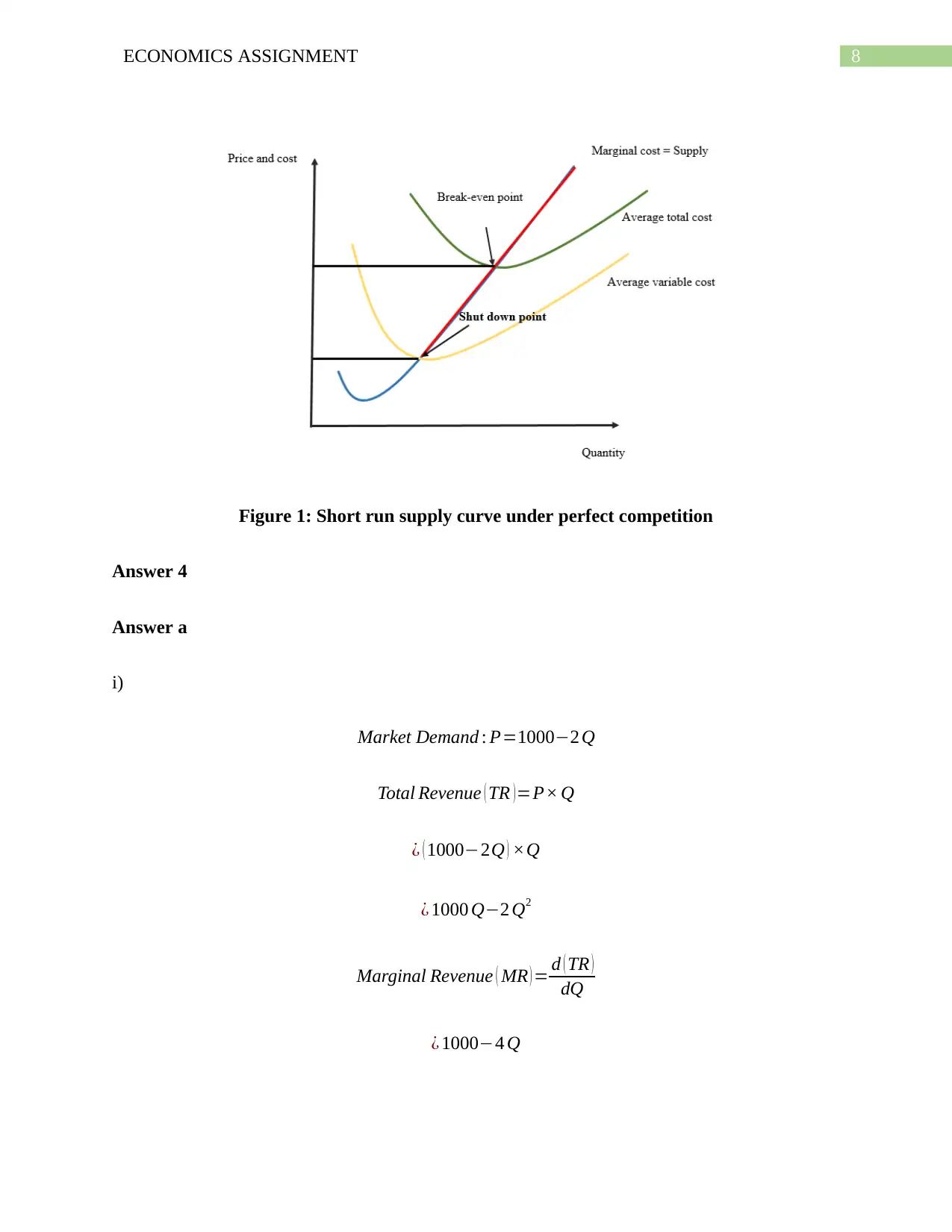
8ECONOMICS ASSIGNMENT
Figure 1: Short run supply curve under perfect competition
Answer 4
Answer a
i)
Market Demand : P=1000−2 Q
Total Revenue ( TR )=P× Q
¿ ( 1000−2Q ) ×Q
¿ 1000 Q−2 Q2
Marginal Revenue ( MR ) = d ( TR )
dQ
¿ 1000−4 Q
Figure 1: Short run supply curve under perfect competition
Answer 4
Answer a
i)
Market Demand : P=1000−2 Q
Total Revenue ( TR )=P× Q
¿ ( 1000−2Q ) ×Q
¿ 1000 Q−2 Q2
Marginal Revenue ( MR ) = d ( TR )
dQ
¿ 1000−4 Q
⊘ This is a preview!⊘
Do you want full access?
Subscribe today to unlock all pages.

Trusted by 1+ million students worldwide
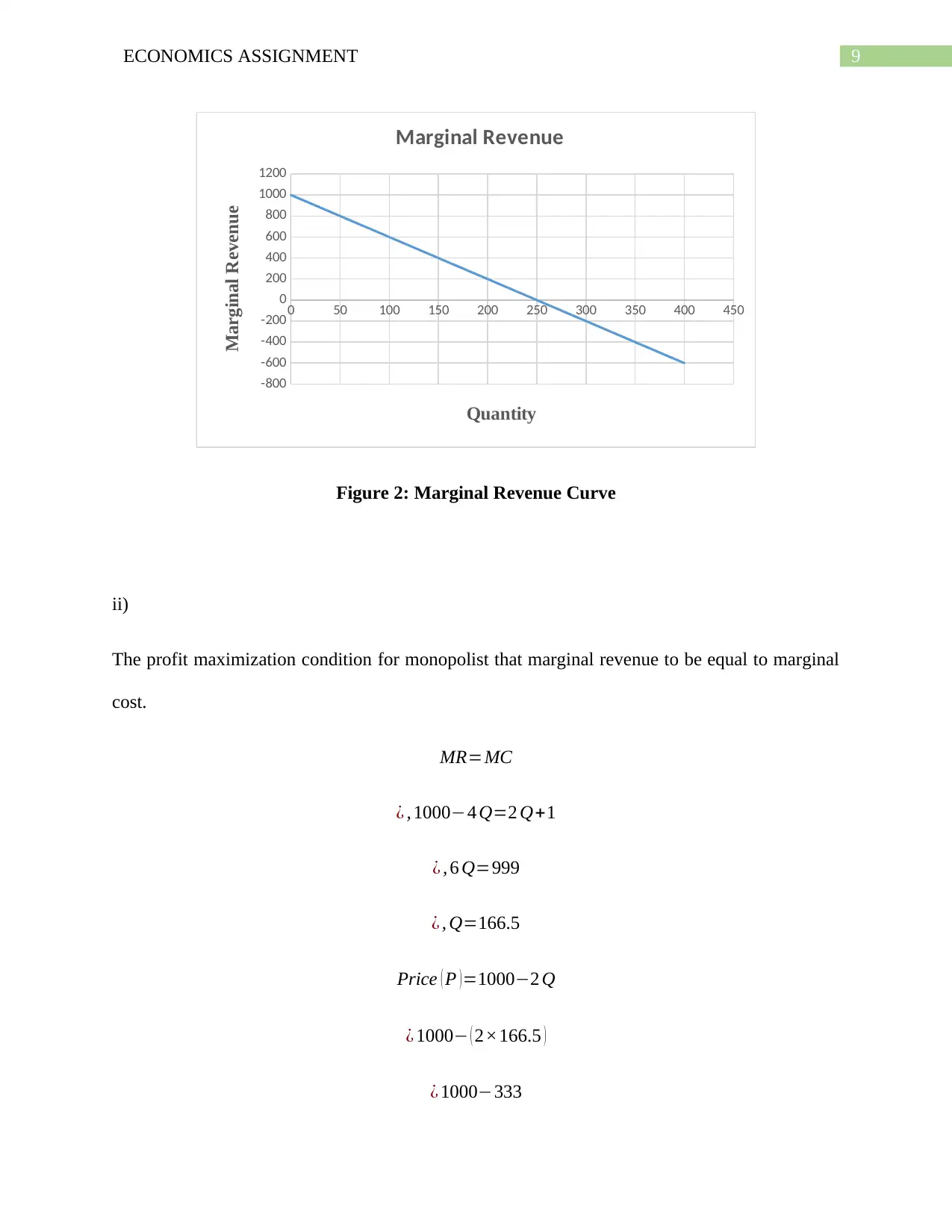
9ECONOMICS ASSIGNMENT
0 50 100 150 200 250 300 350 400 450
-800
-600
-400
-200
0
200
400
600
800
1000
1200
Marginal Revenue
Quantity
Marginal Revenue
Figure 2: Marginal Revenue Curve
ii)
The profit maximization condition for monopolist that marginal revenue to be equal to marginal
cost.
MR=MC
¿ , 1000−4 Q=2 Q+1
¿ , 6 Q=999
¿ , Q=166.5
Price ( P )=1000−2 Q
¿ 1000− ( 2×166.5 )
¿ 1000−333
0 50 100 150 200 250 300 350 400 450
-800
-600
-400
-200
0
200
400
600
800
1000
1200
Marginal Revenue
Quantity
Marginal Revenue
Figure 2: Marginal Revenue Curve
ii)
The profit maximization condition for monopolist that marginal revenue to be equal to marginal
cost.
MR=MC
¿ , 1000−4 Q=2 Q+1
¿ , 6 Q=999
¿ , Q=166.5
Price ( P )=1000−2 Q
¿ 1000− ( 2×166.5 )
¿ 1000−333
Paraphrase This Document
Need a fresh take? Get an instant paraphrase of this document with our AI Paraphraser
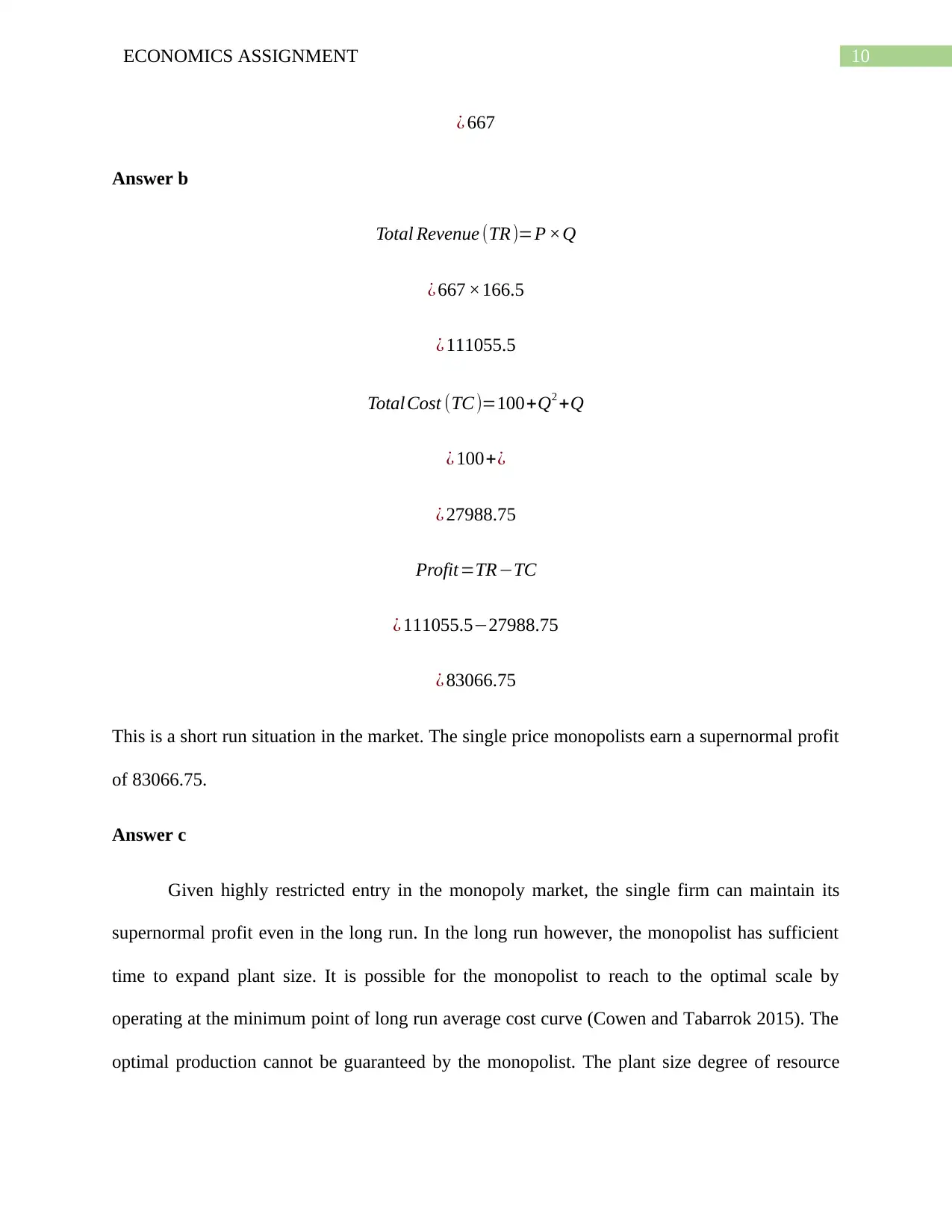
10ECONOMICS ASSIGNMENT
¿ 667
Answer b
Total Revenue (TR)=P ×Q
¿ 667 ×166.5
¿ 111055.5
Total Cost (TC)=100+Q2 +Q
¿ 100+¿
¿ 27988.75
Profit=TR−TC
¿ 111055.5−27988.75
¿ 83066.75
This is a short run situation in the market. The single price monopolists earn a supernormal profit
of 83066.75.
Answer c
Given highly restricted entry in the monopoly market, the single firm can maintain its
supernormal profit even in the long run. In the long run however, the monopolist has sufficient
time to expand plant size. It is possible for the monopolist to reach to the optimal scale by
operating at the minimum point of long run average cost curve (Cowen and Tabarrok 2015). The
optimal production cannot be guaranteed by the monopolist. The plant size degree of resource
¿ 667
Answer b
Total Revenue (TR)=P ×Q
¿ 667 ×166.5
¿ 111055.5
Total Cost (TC)=100+Q2 +Q
¿ 100+¿
¿ 27988.75
Profit=TR−TC
¿ 111055.5−27988.75
¿ 83066.75
This is a short run situation in the market. The single price monopolists earn a supernormal profit
of 83066.75.
Answer c
Given highly restricted entry in the monopoly market, the single firm can maintain its
supernormal profit even in the long run. In the long run however, the monopolist has sufficient
time to expand plant size. It is possible for the monopolist to reach to the optimal scale by
operating at the minimum point of long run average cost curve (Cowen and Tabarrok 2015). The
optimal production cannot be guaranteed by the monopolist. The plant size degree of resource
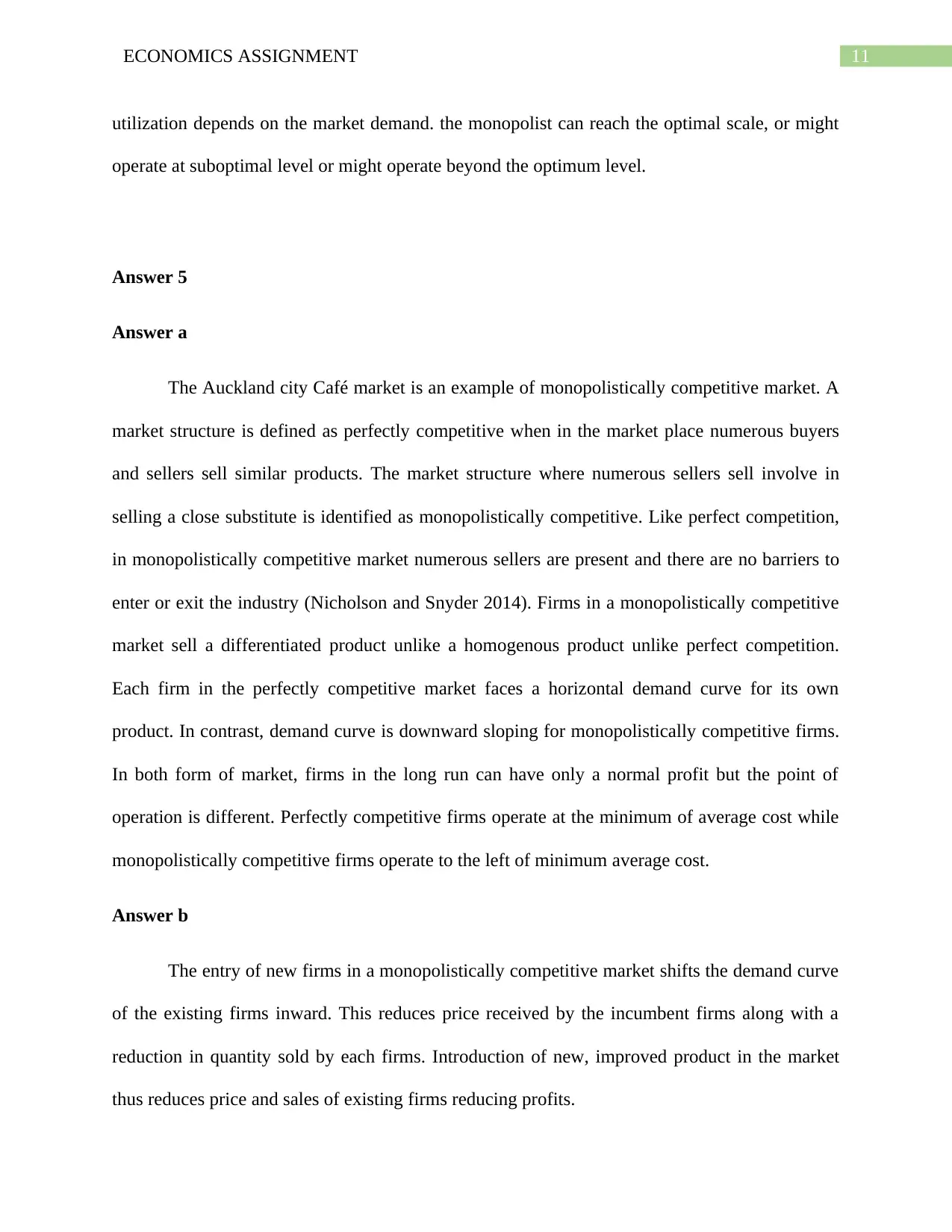
11ECONOMICS ASSIGNMENT
utilization depends on the market demand. the monopolist can reach the optimal scale, or might
operate at suboptimal level or might operate beyond the optimum level.
Answer 5
Answer a
The Auckland city Café market is an example of monopolistically competitive market. A
market structure is defined as perfectly competitive when in the market place numerous buyers
and sellers sell similar products. The market structure where numerous sellers sell involve in
selling a close substitute is identified as monopolistically competitive. Like perfect competition,
in monopolistically competitive market numerous sellers are present and there are no barriers to
enter or exit the industry (Nicholson and Snyder 2014). Firms in a monopolistically competitive
market sell a differentiated product unlike a homogenous product unlike perfect competition.
Each firm in the perfectly competitive market faces a horizontal demand curve for its own
product. In contrast, demand curve is downward sloping for monopolistically competitive firms.
In both form of market, firms in the long run can have only a normal profit but the point of
operation is different. Perfectly competitive firms operate at the minimum of average cost while
monopolistically competitive firms operate to the left of minimum average cost.
Answer b
The entry of new firms in a monopolistically competitive market shifts the demand curve
of the existing firms inward. This reduces price received by the incumbent firms along with a
reduction in quantity sold by each firms. Introduction of new, improved product in the market
thus reduces price and sales of existing firms reducing profits.
utilization depends on the market demand. the monopolist can reach the optimal scale, or might
operate at suboptimal level or might operate beyond the optimum level.
Answer 5
Answer a
The Auckland city Café market is an example of monopolistically competitive market. A
market structure is defined as perfectly competitive when in the market place numerous buyers
and sellers sell similar products. The market structure where numerous sellers sell involve in
selling a close substitute is identified as monopolistically competitive. Like perfect competition,
in monopolistically competitive market numerous sellers are present and there are no barriers to
enter or exit the industry (Nicholson and Snyder 2014). Firms in a monopolistically competitive
market sell a differentiated product unlike a homogenous product unlike perfect competition.
Each firm in the perfectly competitive market faces a horizontal demand curve for its own
product. In contrast, demand curve is downward sloping for monopolistically competitive firms.
In both form of market, firms in the long run can have only a normal profit but the point of
operation is different. Perfectly competitive firms operate at the minimum of average cost while
monopolistically competitive firms operate to the left of minimum average cost.
Answer b
The entry of new firms in a monopolistically competitive market shifts the demand curve
of the existing firms inward. This reduces price received by the incumbent firms along with a
reduction in quantity sold by each firms. Introduction of new, improved product in the market
thus reduces price and sales of existing firms reducing profits.
⊘ This is a preview!⊘
Do you want full access?
Subscribe today to unlock all pages.

Trusted by 1+ million students worldwide
1 out of 16
Related Documents
Your All-in-One AI-Powered Toolkit for Academic Success.
+13062052269
info@desklib.com
Available 24*7 on WhatsApp / Email
![[object Object]](/_next/static/media/star-bottom.7253800d.svg)
Unlock your academic potential
Copyright © 2020–2025 A2Z Services. All Rights Reserved. Developed and managed by ZUCOL.





